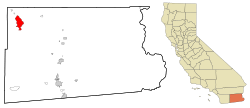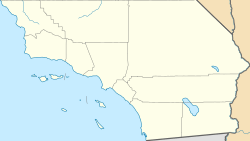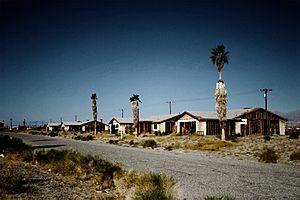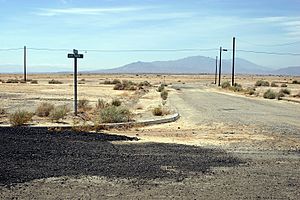Salton City, California facts for kids
Quick facts for kids
Salton City
|
|
|---|---|

Location in Imperial County and the state of California
|
|
| Country | United States |
| State | California |
| County | Imperial |
| Area | |
| • Total | 21.431 sq mi (55.506 km2) |
| • Land | 21.431 sq mi (55.506 km2) |
| • Water | 0 sq mi (0 km2) 0% |
| Elevation | -125 ft (-38 m) |
| Population | |
| • Total | 5,155 |
| • Density | 240.539/sq mi (92.873/km2) |
| Time zone | UTC-8 (Pacific) |
| • Summer (DST) | UTC-7 (PDT) |
| ZIP code |
92275
|
| Area code | 442/760 |
| FIPS code | 06-64294 |
| GNIS feature IDs | 1853413, 2409242 |
Salton City is a special kind of community in Imperial County, California, called a census-designated place (CDP). It's the biggest town in Imperial County located along the Salton Sea. Salton City is part of the larger El Centro, California area. In 2020, about 5,155 people lived there.
Even though it was planned to be a huge resort town for 40,000 people, most of Salton City was never built. Many homes are empty, and a lot of the land is still undeveloped. Because of its quiet, almost empty look, some people call it a modern ghost town, even though its population has grown recently.
Contents
History of Salton City
Salton City was started in 1958 by M. Penn Phillips and the Holly Corporation. They wanted to create a fun resort community right on the Salton Sea. The Salton Sea is a salt lake located near the San Andreas Fault.
However, by 1965, the town didn't grow as much as planned. It was far away from other cities, and there weren't many jobs. The town's problems got worse in the 1970s when the Salton Sea's water levels rose. This caused many buildings near the shore, like the city's marina, to be abandoned.
Later, in the 1980s and 1990s, the Salton Sea became saltier and more polluted. This made it less appealing for fun activities. Many of the original tourist spots, like hotels and restaurants, were closed down.
In the 2000s, Salton City started to grow again. Land and houses were cheap, and a nearby casino opened by the Torres-Martinez Desert Cahuilla Indians brought new people to the area.
Geography of Salton City
Salton City covers about 21.1 square miles (55 square kilometers) of land. This makes it the largest town in the Imperial Valley by land size. The town is mostly flat, with small channels that carry water from the mountains to the west into the Salton Sea. You'll see lots of desert plants, but also palm trees and other trees in the developed areas. Salton City is located between the mountains to the west and the Salton Sea to the east.
Earthquakes in the Area
Earthquakes happen very often around the Salton Sea and in Salton City. This is because many fault lines run through Imperial County. Major fault lines like the Imperial Fault Zone, the San Andreas Fault, and the San Jacinto Fault Zone are only a few miles away. The Brawley Seismic Zone also causes frequent, but usually small, earthquake swarms.
People living here are used to small and medium earthquakes. Buildings are built to strict safety rules to handle them. Even though big earthquakes are possible, most residents are prepared.
Climate of Salton City
Salton City gets a lot of sunshine all year because of its hot desert climate. However, the nearby warm waters of the Salton Sea create a special "microclimate." This means it can feel more humid near the shore, especially from May to September. Sometimes, it can even feel like a tropical climate for a short time.
Salton City is usually very dry. Rain is rare, and even a little rain can cause roads to close or get damaged because the area isn't set up for much rainfall.
| Climate data for Salton City, CA | |||||||||||||
|---|---|---|---|---|---|---|---|---|---|---|---|---|---|
| Month | Jan | Feb | Mar | Apr | May | Jun | Jul | Aug | Sep | Oct | Nov | Dec | Year |
| Record high °F (°C) | 96 (36) |
96 (36) |
104 (40) |
117 (47) |
124 (51) |
126 (52) |
125 (52) |
124 (51) |
126 (52) |
111 (44) |
98 (37) |
90 (32) |
126 (52) |
| Mean daily maximum °F (°C) | 67.8 (19.9) |
73.8 (23.2) |
79.4 (26.3) |
85.1 (29.5) |
93.9 (34.4) |
102.6 (39.2) |
105.7 (40.9) |
105.4 (40.8) |
101.0 (38.3) |
90.3 (32.4) |
78.2 (25.7) |
68.8 (20.4) |
87.7 (30.9) |
| Mean daily minimum °F (°C) | 39.4 (4.1) |
44.8 (7.1) |
49.4 (9.7) |
57.1 (13.9) |
61.6 (16.4) |
68.8 (20.4) |
76.6 (24.8) |
77.0 (25.0) |
70.8 (21.6) |
59.6 (15.3) |
47.9 (8.8) |
38.4 (3.6) |
57.6 (14.2) |
| Record low °F (°C) | 22 (−6) |
22 (−6) |
30 (−1) |
35 (2) |
43 (6) |
50 (10) |
51 (11) |
60 (16) |
49 (9) |
36 (2) |
27 (−3) |
14 (−10) |
14 (−10) |
| Average precipitation inches (mm) | 0.43 (11) |
0.41 (10) |
0.34 (8.6) |
0.10 (2.5) |
0.04 (1.0) |
0.00 (0.00) |
0.13 (3.3) |
0.27 (6.9) |
0.30 (7.6) |
0.28 (7.1) |
0.20 (5.1) |
0.46 (12) |
2.96 (75.1) |
| Source: http://www.wrcc.dri.edu/cgi-bin/cliMAIN.pl?ca4223 | |||||||||||||
Population and People
After a time when its population went down, Salton City has been growing in recent years.
| Historical population | |||
|---|---|---|---|
| Census | Pop. | %± | |
| 1990 | 1,233 | — | |
| 2000 | 978 | −20.7% | |
| 2010 | 3,763 | 284.8% | |
| 2020 | 5,155 | 37.0% | |
| U.S. Decennial Census | |||
2010 Census Information
In 2010, Salton City had 3,743 people. Most people lived in homes, not in group housing. There were 1,204 households. About 42.6% of these households had children under 18. The average household had about 3 people. The average family had about 3.7 people.
The population was spread out by age:
- 33.1% were under 18 years old.
- 9.3% were 18 to 24 years old.
- 23.7% were 25 to 44 years old.
- 21.6% were 45 to 64 years old.
- 12.3% were 65 years or older.
The average age was 31.3 years.
There were 2,026 housing units in Salton City. About 69.2% of these homes were owned by the people living in them, and 30.8% were rented.
2000 Census Information
In 2000, Salton City had 978 people living in 416 households. The average household size was 2.4 people. About 21.4% of households had children under 18.
The population was older in 2000, with 30.4% of residents being 65 years or older. The average age was 49 years. The average income for a household was about $21,563.
From 2004 to 2007, Salton City saw a building boom, with hundreds of new houses being built.
See also
 In Spanish: Salton City para niños
In Spanish: Salton City para niños






